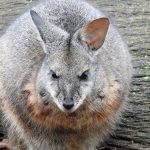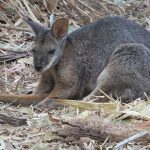TAMMAR WALLABY
The Tammar Wallaby: A Story of Adaptation and Survival
Imagine the gentle hush of dusk settling across the scrublands of southwestern Australia. Amid the softly rustling grasses and the scent of eucalyptus drifting on the cool breeze, a group of agile marsupials begins to stir. Among them is the Tammar wallaby, a remarkable member of the kangaroo family whose story is woven into the very fabric of Australia’s natural heritage.
Physical Description
The Tammar wallaby is a small to medium-sized marsupial, displaying a compact and agile physique:
- Size: Adults range from 50 to 60 centimetres in length and weigh between 4 and 9 kilograms.
- Fur: Their coats are typically greyish-brown across the back, gently transitioning to lighter, almost creamy tones on the underbelly. The fur is soft to the touch, providing both camouflage and protection.
- Distinct Markings: A white cheek stripe stands out on their faces, highlighting their alert, expressive eyes.
- Tail and Limbs: With long, powerful hind legs and a relatively short tail, they are built for quick, bounding movements through undergrowth.
Habitat and Range
| Region | Habitat Characteristics |
|---|---|
| Southwestern Australia | Dense shrubland, heathland, woodland |
| Coastal Areas | Sandy soils, coastal dunes, thickets |
| Offshore Islands | Isolated vegetation, critical conservation |
The Tammar wallaby thrives in environments rich in cover, where the scent of leaf litter and the rustle of wind through shrubs offer both refuge and feeding grounds. Their adaptability allows them to flourish in a variety of landscapes, from sandy coastal dunes to thick inland scrub.
Behaviour and Social Structure
- Nocturnal and Crepuscular: Tammar wallabies are most active under the cover of darkness or during the gentle light of dawn and dusk. The soft patter of their movements is often one of the first signs of life after sunset.
- Social Living: They form groups known as
mobs, typically led by a dominant male. Within these groups, social bonds are strong, and communication relies on keen senses of hearing and smell—subtle noises and scents carry warnings or reassurance. - Vigilance: Their large ears, constantly swivelling, pick up the faintest sounds—a distant predator or the approach of a companion. The earthy aroma of the Australian outback is their backdrop, filled with the complex signals of wildlife interaction.
Diet and Feeding
Tammar wallabies are selective herbivores:
- Diet: They graze on grasses, herbs, leaves, and tender shoots.
- Feeding Adaptations: Their digestive systems are finely tuned to extract maximum nutrition from tough, fibrous plants, making every mouthful count in often-arid environments.
Reproduction and Life Cycle
- Pouch Development: Female Tammar wallabies possess a well-developed pouch. After a brief gestation of 28–30 days, a tiny, vulnerable joey is born and instinctively crawls into the pouch.
- Joey Development: Inside the pouch, the joey continues to grow, cocooned in warmth and safety, nourished by its mother’s milk for several months.
- Embryonic Diapause: A remarkable adaptation allows females to pause the development of a new embryo until conditions are ideal—an evolutionary safeguard that helps ensure the survival of their young.
Conservation Status
On some offshore islands, Tammar wallaby populations are under severe threat:
- Status: Classified as Endangered or Critically Endangered in certain areas.
- Threats:
The Conservation Message
The Tammar wallaby’s story is a testament to resilience and adaptation. Yet, it also serves as a gentle reminder of the delicate balance in nature. Protecting these unique marsupials means safeguarding the intricate ecosystems they call home, where every rustle in the grass and every scent on the breeze is part of a much larger story.
- By supporting habitat restoration and responsible land management, we help ensure that future generations can experience the quiet wonder of Tammar wallabies bounding through the evening light.
- Conservation is not just about protecting a single species, but about cherishing the tapestry of life that sustains us all.
Summary Table
| Feature | Description |
|---|---|
| Size | 50–60 cm length, 4–9 kg weight |
| Distinctive Marking | White cheek stripe |
| Activity Pattern | Nocturnal and crepuscular |
| Social Structure | Lives in mobs (group with dominant male) |
| Diet | Grasses, herbs, leaves, shoots |
| Reproduction | Pouch development, embryonic diapause |
| Conservation Status | Endangered/Critically Endangered (some areas) |
Final Thought
In the gentle twilight of the Australian bush, the Tammar wallaby moves quietly, a small yet significant ambassador for the wild. Their survival rests not just in their own extraordinary adaptations, but in our willingness to listen, learn, and protect the worlds they inhabit.

















